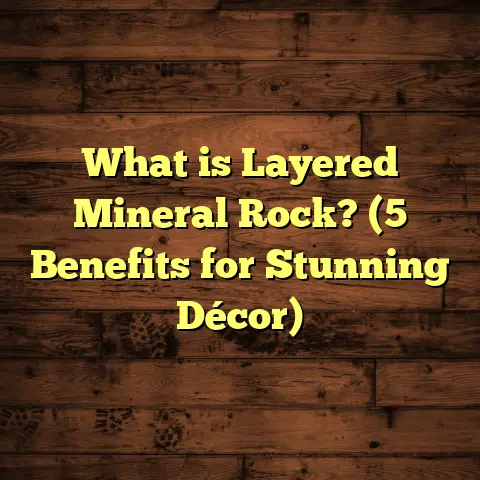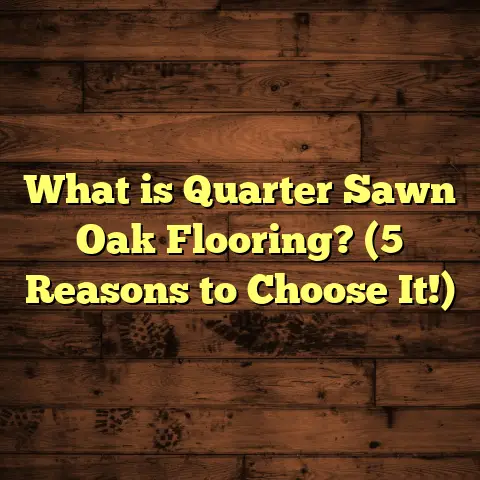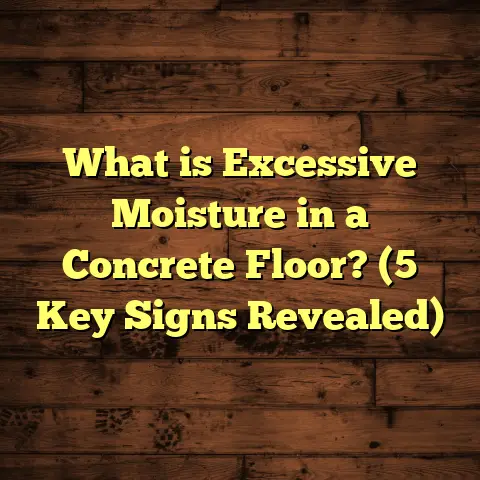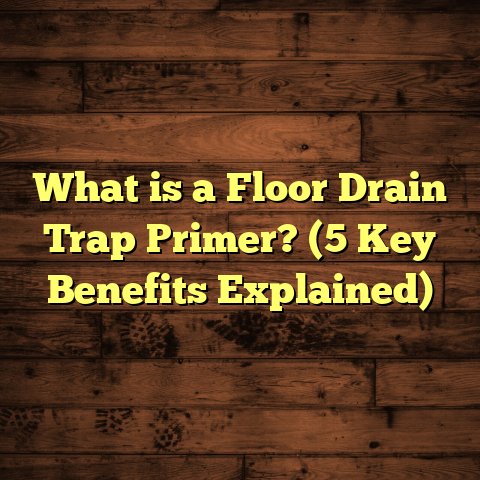What Is LVP Flooring? (5 Things You Must Know About Acronyms)
“The details are not the details. They make the design.” – Charles Eames
I always start with this quote when talking about flooring because, honestly, the choices we make down to the smallest detail can completely change the look and feel of a home. One of the most popular options I get asked about lately is LVP flooring. If you’ve heard the term tossed around but aren’t quite sure what it means or if it’s right for your space, stick with me. I’ll walk you through everything I’ve learned over the years working hands-on with different flooring types, especially LVP.
What Is LVP Flooring?
Let me break it down for you. LVP stands for Luxury Vinyl Plank. It’s a type of vinyl flooring designed to mimic the look of hardwood planks but with some advantages that traditional wood flooring doesn’t offer.
Unlike basic vinyl sheets, LVP comes in individual planks that usually have a textured surface to imitate wood grain. The layers typically include:
- A wear layer that protects against scratches and stains,
- A printed design layer that gives it the wood look,
- A core layer for durability,
- And sometimes a backing layer for stability and moisture resistance.
The whole idea behind LVP is to combine aesthetic appeal with durability and ease of maintenance. Over the years, I’ve installed LVP in kitchens, basements, and even high-traffic commercial spaces. What stands out immediately is how realistic it looks while being easier to maintain and install than real wood.
Breaking Down LVP: Anatomy and Variations
Understanding what makes up LVP helps you appreciate why it’s so popular.
The Wear Layer: Your Floor’s Armor
When I first started installing vinyl floors, I didn’t pay much attention to wear layers. But after seeing floors scratch or dull quickly, I realized this layer is key.
- The wear layer is a transparent coating on top of the printed design.
- Thickness ranges from around 6 mil to 30 mil.
- Thicker wear layers mean better resistance to scratches, dents, and stains.
For residential use, I recommend a wear layer of at least 12 mils. In commercial settings, 20 mil or more is better. My clients who go for thinner layers often regret it within a couple of years.
Design Layer: The Look and Feel
This is where technology shines. High-resolution printing combined with embossing or texture gives LVP its wood-like appearance.
I remember one project where a client insisted on real oak hardwood but couldn’t afford it. We chose a high-end LVP with embossed grain textures that fooled even their closest friends.
Core Layer Types: SPC vs. WPC
This is one of those acronyms that confuse a lot of people.
- SPC (Stone Plastic Composite): This core uses limestone composite mixed with plastic. It’s denser and harder.
- WPC (Wood Plastic Composite): This core contains wood fibers and plastic, making it lighter and softer.
I’ve installed both types extensively. SPC is fantastic for heavy traffic and commercial use due to its rigidity. WPC offers more cushion, which some homeowners love for comfort in living areas or kitchens.
Backing Layer: Stability and Moisture Protection
Not all LVP has a backing layer, but when it does, it adds stability and moisture resistance.
Some products also include an attached underlayment layer to reduce noise and add comfort. From personal experience, I always prefer LVP with this feature in upstairs rooms or apartments.
Why Choose LVP? Comparing It to Other Flooring Options
You might wonder: why choose LVP over hardwood, laminate, or tile? I’ve tried all these options in different projects and here’s what I found.
Hardwood Flooring: The Classic
Hardwood floors have that undeniable charm and warmth. Their natural grain and aging process add character over time. But they come with some drawbacks:
- Cost: Hardwood can cost anywhere from $8 to $15 per square foot just for materials, not including labor.
- Maintenance: They need refinishing every few years, and moisture is a big enemy.
- Installation: It requires professional installation and can take days.
In one of my early projects installing solid oak hardwood in a historic home, the costs ballooned due to labor complexity and delays caused by subfloor prep. Plus, after just two years, water damage near the kitchen sink required expensive repairs.
LVP offers a solution here — usually costing between $2 to $7 per square foot depending on quality — with waterproof features that protect against spills and humidity. And installation can be much quicker.
Laminate Flooring: The Budget-Friendly Alternative
Laminate flooring also mimics wood but is made from fiberboard topped with a photographic layer and protective coating.
Here’s what I’ve seen:
- Laminate looks good but feels hard and cold underfoot.
- It’s prone to swelling if water seeps in.
- Installation is somewhat similar to LVP but laminate doesn’t handle moisture well.
One homeowner I worked with chose laminate for their basement before I recommended switching to LVP after they experienced warping following flooding. That experience convinced me that if moisture is a concern, LVP is the safer bet.
Tile Flooring: Durable but Cold
Tile is durable and great in wet areas but can be cold and slippery. It’s also very labor-intensive to install.
In commercial spaces like cafes or retail stores where spills happen often, I’ve seen tile crack or grout discolor over time without proper maintenance. LVP offers warmth underfoot and can mimic many tile patterns without coldness or slipperiness.
Carpet: Comfort versus Practicality
Carpet definitely has comfort going for it but tends to trap dirt and allergens.
I’ve installed carpet in bedrooms but often recommend hard surface floors like LVP in busy areas due to ease of cleaning. For families with pets or kids, LVP is usually less stressful.
Five Things You Must Know About LVP Acronyms
People often get confused because there are several acronyms floating around related to vinyl flooring. Here’s what I’ve learned that helps clear things up.
1. LVP vs. LVT (Luxury Vinyl Tile)
You might see LVT (Luxury Vinyl Tile) alongside LVP. The main difference? Shape.
- LVP comes in plank shapes designed to look like wood.
- LVT looks like tile or stone squares or rectangles.
The material is very similar otherwise, but your choice depends on your design preference.
I once helped a client choose between stone-look LVT and wood-look LVP for their kitchen renovation. They picked LVT for its stone pattern but wanted the warmth of wood elsewhere — so I suggested combining both types in different rooms for variety without sacrificing durability.
2. SPC (Stone Plastic Composite) vs WPC (Wood Plastic Composite)
These are types of cores used in luxury vinyl floors:
- SPC (Stone Plastic Composite) uses a limestone composite core.
- WPC (Wood Plastic Composite) uses a wood fiber core mixed with plastic.
SPC tends to be denser, harder, and more rigid — great for heavy traffic areas like retail stores or family rooms.
WPC is softer and offers more cushion underfoot, which some homeowners find more comfortable — especially in kitchens where standing for long periods is common.
3. Wear Layer Thickness Matters
This number is crucial for durability. It’s measured in mils (thousandths of an inch).
- Residential wear layers: usually 6-20 mils
- Commercial wear layers: 20+ mils
For my personal projects, I prefer at least 12 mils for homes with kids or pets; it really helps prevent scratches and scuffs.
One study showed floors with thicker wear layers lasted nearly twice as long under typical household conditions compared to thinner ones.
4. Waterproof vs Water-Resistant
Not all vinyl floors are equal in water protection.
- Most LVP is waterproof.
- Laminate usually is only water-resistant.
This waterproof nature is a game-changer for basements or bathrooms where moisture is common.
In one of my installs, a client spilled red wine on their waterproof LVP — within seconds I cleaned it up with no stain or damage at all.
5. Installation Types: Glue Down, Click-Lock, Loose Lay
There are different ways to install LVP:
- Glue down: Permanently adheres planks to the subfloor.
- Click-lock: Planks snap together without glue; great for DIY.
- Loose lay: Heavy planks stay in place by weight and friction.
I’ve used all three methods depending on location and project scope. Click-lock is my favorite for quick installs without sacrificing durability.
Each method has pros and cons:
| Installation Type | Pros | Cons |
|---|---|---|
| Glue Down | Secure, very stable | Time-consuming; messier |
| Click-Lock | Quick DIY-friendly | Slightly less permanent |
| Loose Lay | Easy installation; reusable | Can shift if subfloor uneven |
How I Evaluate Quality When Choosing LVP Products
With so many brands out there, picking good quality LVP can feel overwhelming.
Here’s how I personally break it down:
Look for Manufacturer Certifications
I always check if the product meets ANSI standards (American National Standards Institute) for wear layer thickness and durability.
Also, FloorScore certification means low VOC emissions — important for indoor air quality.
Check Customer Reviews & Longevity Reports
Reading reviews from other installers helps spot recurring issues like fading or edge lifting.
A few years ago, a cheaper brand disappointed me with rapid wear after just one year despite a thick wear layer claim — something those reviews predicted!
Sample Testing Before Buying Large Quantities
I never buy more than a small box initially. Installing samples lets me test:
- How easy the planks snap together,
- Surface texture realism,
- Noise levels when walking,
- And cleanability after spills or stains.
One client was sold on a price deal but hated how the floor felt underfoot once installed — thankfully we switched before full installation.
Personal Stories With Different Types of LVP Cores
Here are some real-world examples from my projects:
SPC Core in High Traffic Retail Space
In a boutique store downtown, we installed SPC LVP with a 20-mil wear layer glue-down method.
After six months of constant foot traffic — including shopping bags dragging across floors — there were zero scratches or dents visible. The client was thrilled because they avoided costly tile replacement plans.
WPC Core in Family Kitchen
For a family renovating their kitchen, WPC core LVP was chosen for its softer feel underfoot.
The homeowner told me standing at the counter felt much easier on her knees during meal prep compared to their previous tile floor. Cleanup was simple after daily spills — no warping or staining occurred after eight months now.
Maintenance Tips That Have Saved Me Time (and Clients Money)
One reason I like recommending LVP is how easy it is to maintain compared to hardwood or tile.
Here are my go-to tips that have helped keep floors looking good longer:
- Sweep or vacuum regularly to prevent dirt buildup that can scratch surfaces.
- Avoid waxes or harsh chemicals; mild soap and water work best.
- Quickly wipe spills to avoid staining.
- Use felt pads under furniture legs to prevent dents.
- If scratched lightly, some manufacturers offer repair kits that blend well with colors.
In one job where pets lived inside, regular sweeping plus occasional damp mop kept floors scratch-free despite claws — something hardwood couldn’t handle without refinishing every few years.
Cost Breakdown From My Experience (With FloorTally Help)
Budgeting can be tricky because prices vary widely by region, brand quality, installation method, and room size.
Here’s what I usually see:
| Flooring Type | Material Cost per Sq Ft | Installation Cost per Sq Ft | Average Total Cost per Sq Ft |
|---|---|---|---|
| Hardwood | $8 – $15 | $4 – $8 | $12 – $23 |
| Laminate | $1 – $3 | $2 – $4 | $3 – $7 |
| Tile | $2 – $10 | $5 – $10 | $7 – $20 |
| LVP (Luxury Vinyl Plank) | $2 – $7 | $2 – $5 | $4 – $12 |
Using tools like FloorTally has made my estimating much smoother by factoring local labor rates along with materials automatically. It also considers waste percentages — important because cutting planks always generates scrap (usually 5%-10%).
For example: On a 500 sq ft kitchen install using mid-range SPC core LVP at $4 material + $3 labor per sq ft with 7% waste factored in:
- Material needed = 500 sq ft × 1.07 = 535 sq ft
- Material cost = 535 × $4 = $2140
- Labor cost = 500 × $3 = $1500
- Total estimated cost = $3640
This kind of detail helps avoid surprises during budgeting conversations with clients or yourself!
Design Tips: Making Your Space Pop With LVP
One thing I love about LVP is how versatile it is design-wise:
- You can get virtually any wood look: oak, hickory, maple, walnut.
- Some even mimic exotic woods like bamboo or teak.
- Colors range from light grays and whites (very trendy now) to deep browns and blacks.
In one project, we paired light gray LVP planks with white cabinets for a modern farmhouse style that really feels fresh yet cozy.
Don’t forget about plank width:
- Narrow planks (3–4 inches) give traditional vibes.
- Wider planks (6–9 inches) offer a contemporary look.
Also consider plank length; longer planks create fewer seams which some people prefer visually.
Addressing Common Concerns About LVP Flooring
I get asked these questions frequently:
Will My Floor Look Fake?
If you pick good quality brands with embossed textures and realistic prints, no — it won’t look fake.
Many clients tell me guests ask if they’re real hardwood after installation!
How Long Does It Last?
With proper care and at least a 12 mil wear layer, expect around 15–20 years lifespan in residential use—sometimes longer in low traffic areas.
Can It Be Installed Over Existing Floors?
Often yes! If your subfloor is level and clean, you can install click-lock LVP over tile or vinyl without removing old floors—saving time and money.
Wrapping Up My Thoughts on LVP Flooring
Choosing flooring isn’t just picking something pretty — it’s about balancing looks with durability,
comfort,
maintenance,
and budget.
LVP hits all those marks better than anything else I’ve tested recently — especially if moisture or pets are involved.
If you’re thinking about updating your floors,
don’t overlook this option just because it’s vinyl.
Good-quality Luxury Vinyl Plank flooring can surprise you with how much like real wood it looks,
how comfy it feels,
and how little hassle it creates over years of use.
I hope my experiences help you feel confident exploring LVP for your next flooring project! Need advice specific to your space? Just ask — I’m here to help!





